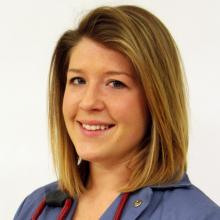 Palpation is one of the most common things done on a dairy farm. Whether you are checking cows for pregnancy during a herd check, or performing a physical, palpation is a skill you should have under your belt at all times.
Palpation is one of the most common things done on a dairy farm. Whether you are checking cows for pregnancy during a herd check, or performing a physical, palpation is a skill you should have under your belt at all times.
When I first began palpating cows, I would be so concerned about being able to diagnose a pregnancy and feel ovarian structures that I would forget about the basics. This caused me to be unable to determine the correct location of the ovaries in addition to if a cow was pregnant. Bottom line: I was trying to get to Oz without following the yellow-brick road.
I was given the best piece of advice during my first week of this externship – the main focus while in the cow, when you first start out palpating, should be retraction. Once you have mastered retraction of the uterus, you will be able to examine each of the horns and accompanying ovaries completely. Focus on open (non-pregnant) cows first. This will allow you to familiarize yourself with what a “normal”, non-pregnant uterus feels like. Then, once you feel that you have mastered that, anything that you palpate that is not open (i.e.: pregnant, pyometra, tumor) will feel “abnormal”.
Once you have gotten this far (which will take time, like weeks time) it is good to educate yourself on the more detailed aspects of the reproductive tract, such as the structures of the ovaries and aging pregnancies. A very useful book that I refer to is “The oestrus cycle of the cow. A photographic atlas by Manual Fernandez Sanches.
Happy Palpating! Remember to wear a shoulder guard and waterproof pants so you can keep your coveralls clean and use plenty of lubrication to minimize irritating the cow!
